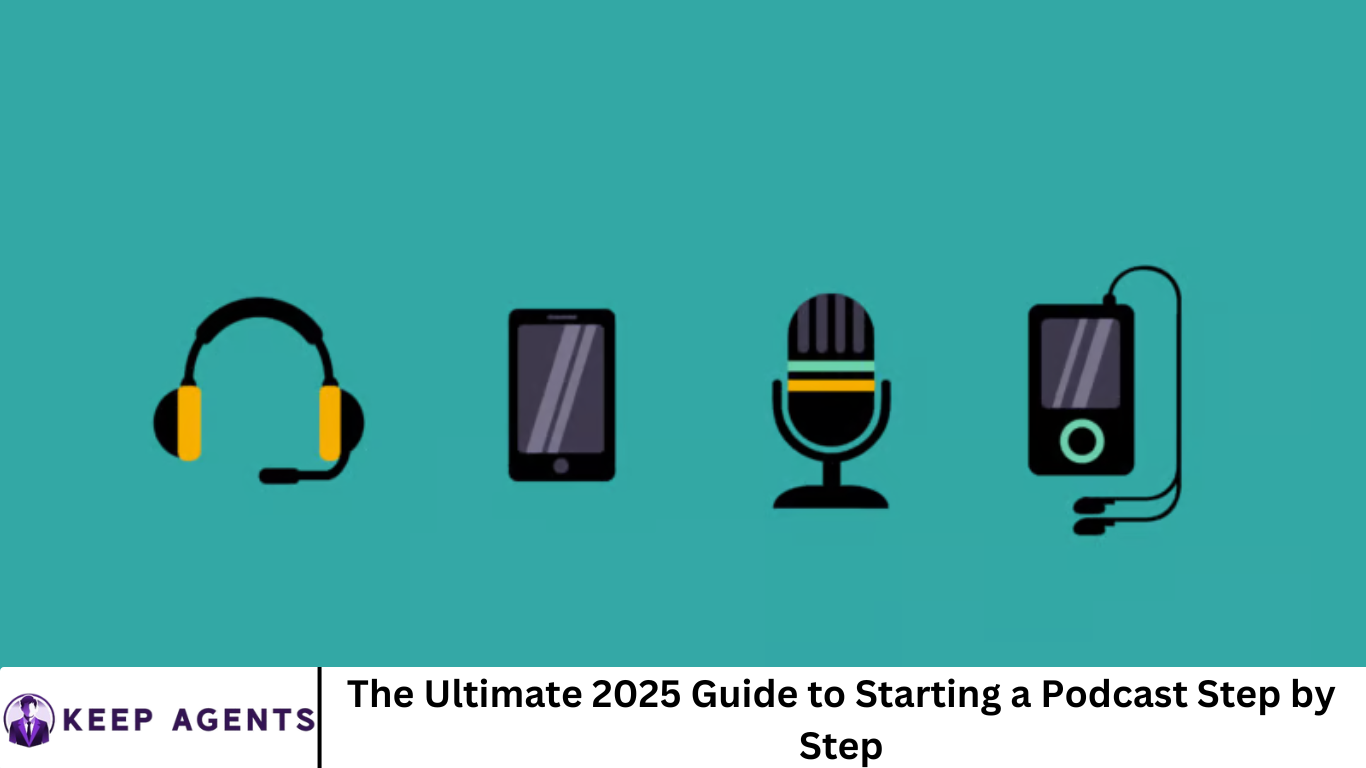Launching a podcast can feel overwhelming—especially if you’re doing it alone. But the good news is, you don’t have to. Since 2009, Buzzsprout has helped over 300,000 podcasters launch their shows.
We’ve taken everything we’ve learned over the years and packed it into this comprehensive guide. We’ve broken the process down into 10 simple steps to help you confidently create, launch, and grow a podcast you’re proud of.
More Read: Inspire Young Writers: 100 Creative Prompts to Jumpstart Storytelling Adventures
Why Start a Podcast in 2025?
Podcasting is booming—with over 465 million listeners worldwide and new formats flourishing, it’s an ideal time to launch. In 2025:
- A rising audience: Audio content consumption keeps growing.
- Low entry barrier: Equipment and hosting solutions are affordable.
- Monetization potential: Sponsorships, memberships, and courses are mainstream.
- Thought leadership: A podcast positions you as an authority in your niche.
When people search “how to start a podcast step by step,” they expect clear, up-to-date guidance. That’s exactly what this article offers!
Step 1: Define Your Podcast’s Purpose & Audience
Clarity = longevity. Before diving in:
- Ask yourself: Why am I podcasting? Want to educate, entertain, inspire, or promote your brand?
- Identify your audience: Age, interests, challenges—this will guide your tone, content, and promotion.
- Draft a mission statement: e.g., “A weekly podcast for busy solopreneurs to learn marketing tactics in under 30 minutes.”
This foundational clarity ensures consistent direction and builds a loyal listener base.
Step 2: Choose Your Niche & Format
A. Pick a niche
Your niche should balance:
- Passion: Topics you love discussing.
- Expertise: Topics you know well.
- Demand: Topics with active audiences and search volume.
Research on Google Trends and podcast directories helps here.
B. Select a format
Popular formats:
- Solo: You speak directly to listeners.
- Co-host: Two or more hosts riff on a topic.
- Interview: Expert guests share insights.
- Panel: Multiple guests discussing in a roundtable.
Each has its pros and cons; choose based on your comfort, audience, and goals.
Step 3: Plan Content & Episode Structure
Consistency is key—plan your episodes ahead. Here’s how:
- Brainstorm ideas: Create a list of 20–30 episode titles.
- Structure each episode:
- Teaser/intro (15–30 seconds)
- Main content (15–45 minutes)
- Summary or call to action (e.g., “subscribe,” “visit our website”)
- Batch recording: Record multiple episodes per session for efficiency.
- Write outlines or scripts: Keeps the flow professional without sounding forced.
Step 4: Gather Equipment & Software
By 2025, podcast gear is affordable without compromising quality.
Microphones
- USB mics (easy plug-and-play):
- Blue Yeti
- Audio-Technica ATR2100x
- XLR mics (studio quality):
- Shure SM7B
- Rode PodMic
Headphones
- Closed-back, over-ear:
- Audio-Technica ATH-M50x
- Sennheiser HD280 Pro
Recording & Editing Software
- Audacity (free, cross-platform)
- Reaper (affordable, powerful)
- Adobe Audition (professional suite)
Extras
- Boom arm or mic stand
- Pop filter
- Acoustic treatment (foam panels or sound blankets)
Investing in good gear pays off—crisp audio keeps listeners engaged.
Step 5: Record High-Quality Audio
Follow this checklist before hitting record:
- Find a quiet, echo-free space.
- Use your mic properly—6–12 inches away, slightly off-axis.
- Talk at a consistent volume, and test mic levels before starting.
- Use monitoring—listen through headphones as you record.
- Backup recordings—save raw files immediately after recording.
Step 6: Edit & Enhance Sound Quality
Editing transforms raw audio into polished content.
- Clean up:
- Remove breaths, “umms,” and pauses.
- Apply noise reduction carefully.
- Balance levels:
- Normalize dialogue to around –16 LUFS (industry standard).
- Use compression to smooth volume.
- Add music & effects:
- Royalty‑free intro/outro music (sites like Free Music Archive or premium libraries).
- Simple sound effects to highlight key moments.
- Export:
- Use MP3, 44.1 kHz, 128–192 kbps.
- Tag metadata (title, host, season, episode art).
Quality editing elevates your podcast’s professionalism.
Step 7: Design Cover Art & Brand Assets
Your podcast art is its “face”—don’t skimp.
- Required spec: 3000×3000 px, JPEG or PNG, ≤ 500 KB.
- Design tools: Canva, Adobe Illustrator, or hire a designer.
- Include: Title, subtitle/tagline, consistent brand colors, clear font, simple imagery.
Additional assets:
- Episode thumbnails (can reuse or tweak main art).
- Promo audiograms (via Headliner or Wavve) for social media.
- Fill a Media Kit with your bio, stats, and guest info for potential sponsors.
Step 8: Host Your Podcast & Distribute
You need a podcast host to store and distribute files via RSS feed. Compare options:
- Buzzsprout
- Libsyn
- Podbean
- Anchor (free but basic features)
Consider: pricing, storage limits, analytics, monetization options.
Once hosted, submit your podcast to directories:
- Apple Podcasts
- Spotify
- Google Podcasts
- Amazon Music
- Stitcher
- Others (e.g., Deezer, iHeartRadio)
Also, link your RSS feed in your website or newsletter for direct access.
Step 9: Launch with Impact
A solid launch strategy boosts discovery and downloads:
- Prepare 3–5 episodes to release on launch day—this gives new listeners enough content to subscribe.
- Write compelling episode descriptions with keywords like “podcasting,” “how to start a podcast,” and “guide.”
- Create a launch checklist:
- Release on weekdays (Tuesday–Thursday sees higher engagement).
- Leverage social media, email, and blog to announce launch.
- Ask friends, guests, or colleagues to leave ratings and reviews.
- Host a virtual launch event: live Q&A or episode preview on Instagram, Facebook, or YouTube.
Step 10: Promote, Grow & Monetize
To grow beyond launch:
Audience Growth
- Cross‑promotion with other podcasters.
- Guest appearances on relevant shows.
- Social media content: audiograms, quotes, polls.
- Newsletter: collect emails to nurture listeners.
Monetization Strategies
- Sponsorships: Reach 1,000+ downloads/episode.
- Affiliate links: Promote tools you use (like your mic).
- Paid tiers or memberships on Patreon.
- Online courses or consulting derived from episode content.
- Live events or branded merch once you have an engaged base.
Aim for steady growth—not overnight riches.
Frequently Asked Question
What equipment do I need to start a podcast in 2025?
To start a podcast in 2025, you’ll need a quality microphone (USB or XLR), headphones, a computer, and recording/editing software like Audacity, Reaper, or Adobe Audition. Optional gear includes a boom arm, pop filter, and audio interface for better sound quality.
How much does it cost to start a podcast?
Starting a podcast can cost as little as $100–$500. Basic setups (USB mic and free editing software) are budget-friendly, while pro-level setups with studio-quality gear and paid hosting may cost more. Hosting platforms usually charge $5–$20/month.
How long should my podcast episodes be?
Ideal podcast length depends on your content and audience. Most successful podcasts range between 20 and 45 minutes. The key is to keep episodes engaging, consistent, and appropriate for your niche.
How do I get my podcast on Apple, Spotify, and Google?
First, upload your episodes to a podcast hosting provider (like Buzzsprout, Libsyn, or Podbean). Then submit your podcast’s RSS feed to directories like Apple Podcasts, Spotify, and Google Podcasts through their respective podcast submission portals.
Can I make money from podcasting in 2025?
Yes! Podcasters can monetize through sponsorships, affiliate marketing, premium content, Patreon memberships, merchandise, or by offering services/courses. Monetization usually becomes easier once you build an engaged audience.
Do I need a website for my podcast?
A website isn’t required but is highly recommended. A podcast website boosts SEO, helps with discoverability, and gives you a platform to post show notes, transcripts, and collect email subscribers. Most podcast hosts offer simple website builders.
How often should I release new podcast episodes?
Most podcasters release weekly episodes, which balances quality and consistency. However, some succeed with bi-weekly or daily formats. Choose a schedule you can sustain long term and stick to it.
Conclusion
Podcasting in 2025 offers more opportunity than ever before—and now, you have the roadmap to get started. Whether you’re building a brand, sharing your expertise, or simply connecting with like-minded people, a podcast is one of the most powerful tools to grow your voice and audience.Remember: You don’t need to be perfect to start—you just need to start. With consistency, clarity, and passion, your podcast can become a platform that inspires, educates, and entertains.


